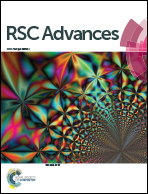On-site marine oil spillage monitoring probes formed by fixing oxygen sensors into hydrophobic/oleophilic porous materials for early-stage spotty pollution warning†
Abstract
In this study, an efficient on-site marine oil spillage monitoring probe was developed by fixing oxygen consumption sensors into hydrophobic/oleophilic oil-absorbing porous materials. The impact of thickness and characters of the porous materials, the types of spilled oil, and the presence of salts and vibration in water on the parameters of the obtained signals was investigated. The probe could be used to detect the various representative types of spilled oils including lubricating oil, corn oil, soybean oil, n-hexane, petroleum ether and toluene, even in simulated sea water vibrating at different levels, having over 33 times reduced reliable low detection limit (RLDL) in detecting soybean oil in water (from 36.5 g L−1 to 1.1 g L−1). The response time and signal-to-noise ratios (SNRs) of the probe varied greatly with the dynamic absorbing speed and oxygen barrier property of the spilled oils in the porous material, respectively. The probe showing the highest SNR of 190 dB for a 50 g L−1 on-site soybean oil spillage and the fastest response time of 9 s for a 50 g L−1 on-site toluene spillage in water may potentially be used as a key component in near-shore marine oil spillage monitoring systems to provide early-stage pollution warning.



 Please wait while we load your content...
Please wait while we load your content...